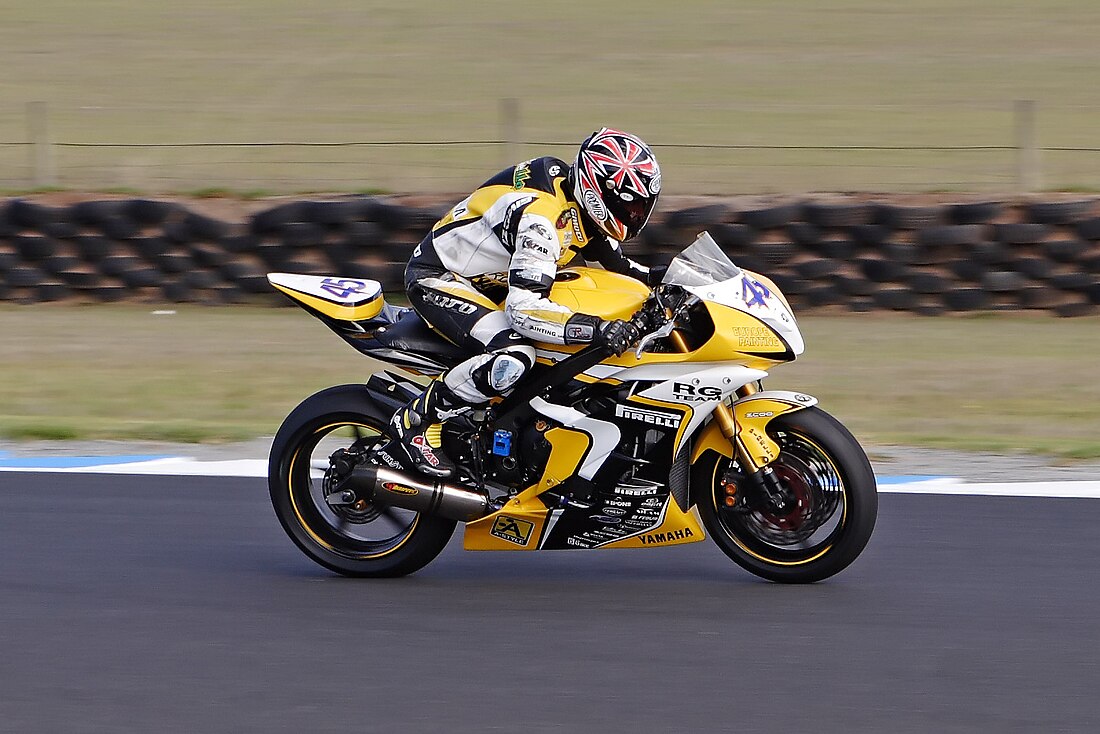Top Qs
Timeline
Chat
Perspective
Supersport World Championship
International motorcycle racing From Wikipedia, the free encyclopedia
Remove ads
The Supersport World Championship, abbreviated to WorldSSP, is a motorcycle racing competition on hard-surfaced circuits, based on mid-sized sports motorcycles. Competition machines were originally based on production-based motorcycles with 600 cc to 955 cc engines, depending on the number of cylinders. After trials in UK national series British Supersport, from 2022 the regulations have changed to allow eligibility of larger-displacement engines, to reflect the engine sizes being produced and encourage different manufacturers.[1][2]

The championship runs as a support class to the Superbike World Championship, which is similarly based on large production-based sports motorcycles. The championship, organized and promoted as its parent series by FGSport—renamed Infront Motor Sports in 2008[3]—until 2012 and by Dorna from the 2013 season onwards,[4] is sanctioned by the FIM.
Remove ads
Overview
Supersport was introduced as a support class to the Superbike World Championship in 1990 as a European Championship. The series allows four-cylinder engines up to 600 cubic centimetres (37 cu in), three-cylinder engines up to 675 cubic centimetres (41.2 cu in), and twin-cylinder power plants up to 750 cubic centimetres (46 cu in). In 1997 the championship became a "World Series" and the European title was given to the European Motorcycle Union's European Road Racing Championship. The full title Supersport World Championship was introduced in 1999.[5] Supersport racing has also been one of the most popular classes of national racing for many years.
Competition in the championship is typically fierce, and season domination by a single competitor is unusual. The 2001 championship was particularly notable in this respect, the champion being Andrew Pitt who did not win a single race, but amassed a championship-winning total of points by finishing near the front of the field in almost every race.
Remove ads
Regulations
Summarize
Perspective
Technical regulations
Supersport regulations are much tighter than in Superbikes. The chassis of a supersport machine must remain largely as standard, while engine tuning is possible but tightly regulated. For instance, the displacement capacity, bore and stroke must remain at the homologated size. Modifying the bore and stroke to reach class limits is not allowed.[6] As in World Superbike, a control tyre is used. From 2020 onwards, the tyres no longer have to be road legal and therefore slicks are allowed.
The 2022 season unveiled the "Next Generation" motorcycles and regulations which allowed motorcycles from "gaps in the market" between the traditional supersport configuration of 600cc inline 4 cylinders and superbikes.
The Next Generation regulations bought in headline rules of hard minimum weight, combined bike and rider weight, and maximum RPM limit. Due to these changes allowing a much more varied field, there is a big focus on balancing factors to bring fair competition. This includes concession parts, torque limited map with RPM limit, minimum weight, air restrictor, and modifications, all of which could be changed during the season based on balancing calculations and concession points.
To be eligible, a motorcycle must satisfy FIM's homologation requirements and have a four-stroke engine in one of the following configurations:[6][7][8]
As of 2025, the specifically homologated machines with weight limits are:
(Bold indicates a 2025 addition from the 2023 list.)[9]
Formerly homologated motorcycles include Bimota YB9, Ducati 748, Ducati 749, Honda CBR600F, MV Agusta F3 675, Triumph Daytona 600, Triumph Daytona 675, and Yamaha YZF600R.[10][11]
Sporting regulations
A Supersport World Championship race takes place at almost every Superbike World Championship round. Starting positions are decided by the riders' fastest laps from two 45-minute qualifying sessions. Each race is approximately 100 kilometres (62 mi) long. Typically, the race takes place between the two Superbike races.
The points system is the same for the riders' championship and the manufacturers' championship, but only the highest-finishing motorcycle by a particular manufacturer is awarded the points for the latter championship.
Remove ads
Riders
Riders from all over the world compete in World Supersport, mostly from Europe.
Several riders who were successful in World Supersport have moved on to high-level competitions, notably, Cal Crutchlow, Chaz Davies, and Chris Vermeulen, though others such as Fabien Foret and Kenan Sofuoğlu have spent several years in this championship. Notable female rider María Herrera entered a few races in World Supersport.
WorldSSP Challenge
Starting in 2016, the World Supersport Challenge, a separate points-scoring competition was held at the European-rounds of the Supersport World Championship, run as a category within the main races. Previously, it was known as the European Supersport Cup.
Remove ads
Champions
Remove ads
See also
References
External links
Wikiwand - on
Seamless Wikipedia browsing. On steroids.
Remove ads
